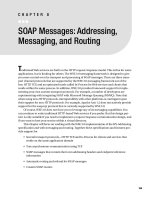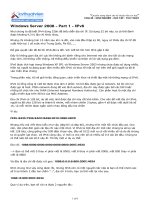ipv6 addressing representation
Bạn đang xem bản rút gọn của tài liệu. Xem và tải ngay bản đầy đủ của tài liệu tại đây (900.24 KB, 63 trang )
1
IPv6 Address
Representation
IPv6 Addressing 2
Objectives
IPv6 Addressing scheme
IPv6 Address Plan
IPv6 Address Types
IPv6 Address with an Embedded IPv4 Address
IPv6 Address Representation for URL
IPv6 and Subnetting
IPv6 Addressing 3
IPv6 Addressing Rules
128 bits (or 16 bytes) long: four times as long as its
predecessor.
2
128
: about 340 billion billion billion billion different
addresses
Colon hexadecimal notation:
addresses are written using 32 hexadecimal digits.
digits are arranged into 8 groups of four to improve the
readability.
Groups are separated by colons
2001:0718:1c01:0016:020d:56ff:fe77:52a3
Note:
DNS plays an important role in the IPv6 world
(manual typing of IPv6 addresses is not an easy thing,
Some zero suppression rules are allowed to lighten this task at
least a little.
IPv6 Addressing 4
IPv6 Address Notation: Example
128.91.45.157.220.40.0.0.0.0.252.87.212.200.31.255
IPv6 Addressing 5
Rule 1- IPv6 Zero Suppression
Some types of addresses contain long sequences of zeros.
To further simplify the representation of IPv6 addresses, a
contiguous sequence of 16-bit blocks set to 0 in the colon
hexadecimal format can be compressed to “::”, known as
double-colon.
For example:
link-local address
FE80:0:0:0:2AA:FF:FE9A:4CA2 FE80::2AA:FF:FE9A:4CA2.
multicast address
FF02:0:0:0:0:0:0:2 FF02::2
loopback address
0:0:0:0:0:0:0:1 ::1
IPv6 Addressing 6
Rule 1- IPv6 Zero Suppression
Zero compression can only be used to compress a single
contiguous series of 16-bit blocks expressed in colon
hexadecimal notation.
You cannot use zero compression to include part of a 16-
bit block.
For example,
cannot express FF02:30:0:0:0:0:0:5 as FF02:3::5
correct representation = FF02:30::5
Leading zeroes in every group can be omitted.
2001:718:1c01:16:20d:56ff:fe77:52a3
IPv6 Addressing 7
Rule 1- IPv6 Zero Suppression
To determine the number of 0 bits represented by the “::”
1. count the number of blocks in the compressed address
2. (-) subtract this number from 8
3. (*) multiply the result by 16.
For example
1. FF02::2
2. two blocks - “FF02” block and “2” block.
3. The number of bits expressed by the “::” is 96 (96 = (8 –
2)×16).
Zero compression can only be used once in a given address.
Otherwise, you could not determine the number of 0 bits
represented by each instance of “::”.
IPv6 Addressing 8
IPv6 Prefixes
The prefix is the part of the address that indicates the bits
that have fixed values or are the bits of the subnet prefix.
Prefixes for IPv6 subnets, routes, and address ranges are
expressed in the same way as Classless Inter-Domain
Routing (CIDR) notation for IPv4.
An IPv6 prefix is written in address/prefix-length notation.
For example, 21DA:D3::/48 and 21DA:D3:0:2F3B::/64 are
IPv6 address prefixes.
Note IPv4 implementations commonly use a dotted decimal
representation of the network prefix known as the subnet
mask. A subnet mask is not used for IPv6. Only the prefix
length notation is supported.
IPv6 Addressing 9
IPv6 Prefixes
10
IPv6 Address Types
IPv6 Addressing 11
IPv6 Addresses: Types and
Scopes
IPv6 Addressing 12
IPv6 Address Categories
IPv6 Addressing 13
IPv6 Address Types
IPv6 Addressing 14
Unicast IPv6 Addresses
The following types of addresses are unicast IPv6 addresses:
Global unicast addresses
Link-local addresses
Site-local addresses
Unique local IPv6 unicast addresses
Special addresses
IPv6 Addressing 15
Global Unicast Addresses
Equivalent to public IPv4 addresses.
Globally routable and reachable on the IPv6 portion of the Internet.
Unlike the current IPv4-based Internet, which is a mixture of both flat and
hierarchical routing, the IPv6-based Internet has been designed from its
foundation to support efficient, hierarchical addressing and routing.
The scope, the portion of the IPv6 internetwork over which the address is
unique, of a global unicast address is the entire IPv6 Internet.
Global scoped communication are identified by high-level 3 bits set to 001 (2000::/3)
IPv6 Addressing 16
Global Unicast Address
Each aggregatable global unicast IPv6 address has three parts:
Fixed portion set to 001 – The three high-order bits are set to 001. The
address prefix for currently assigned global addresses is 2000::/3.
Global Routing Prefix – Site Prefix
Site prefix assigned to an organization (leaf site) by a provider should
be at least a /48 prefix = 45 + high-order bits (001).
/48 prefix represents the high-order 48-bit of the network prefix.
prefix assigned to the organization is part of the provider’s prefix.
Subnet-id - Site
With one /48 prefix allocated to an organization by a provider, it is
possible for that organization to enable up to 65,535 subnets
(assignment of 64-bit’s prefix to subnets).
The organization can use bits 49 to 64 (16-bit) of the prefix received for
subnetting.
Interface-id – Host
The host part uses each node’s interface identifier.
This part of the IPv6 address, which represents the address’s low-order
64-bit, is called the interface ID.
IPv6 Addressing 17
Global Unicast Address: Example
2001:0410:0110::/48 is assigned by a provider
2001:0410:0110:0002::/64 network subnet within the
organization
2001:0410:0110:0002:0200:CBCF:1234:4402 – node address
within the subnet
IPv6 Addressing 18
Global Unicast Address
IPv6 Addressing 19
Global Unicast Address Allocation
IPv6 Addressing 20
Global Unicast Address Allocation
Prefix (hex) Prefix (Binary) Description
2000::/16 0010 0000 0000 0000 Reserved
2001::/16 0010 0000 0000 0001 IPv6 Internet
-ARIN,APNIC,RIPE NCC,LACNIC
2002::/16 0010 0000 0000 0 6 to 4 transition mechanisms
2003::/16 0010 0000 0000 0011 IPv6 Internet - RIPE NCCC
2400:0000::/19
2400:2000::/19
2400:4000::/21
0010 0100 0000 0000 IPv6 Internet
- APNIC
2600:0000::/22
2604:0000::/22
2608:0000::/22
260C:0000::/22
0010 0110 0000 0000
0010 0110 0000 0100
0010 0110 0000 1000
0010 0110 0000 1100
IPv6 Internet
-ARIN
2A00:0000::/21
2A01:0000::/23
0010 1010 0000 0000 0010
1010 0000 0001
IPv6 Internet
-RIPE NCC
3FFF::/16 0011 1111 1111 1110 6 Bone
IPv6 Addressing 21
IPv6 Unicast Address Scopes
Three types of scopes:
1. Link-local scope
Identifies all hosts within a single layer 2 domain.
Called as link-local addresses
2. Unique-local scope
Identifies all devices reachable within an administrative
site or domain typically contains multiple distinct links.
Called as unique-local addresses (ULAs)
3. Global scope
Identifies all devices reachable across the Internet.
Called as global unicast addresses (GUAs)
IPv6 Addressing 22
Local-Use Unicast Addresses
There are two types of local-use unicast addresses:
1. Link-local addresses
used between on-link neighbors and for Neighbor
Discovery Processes.
2. Site-local addresses
used between nodes communicating with other
nodes in the same site.
IPv6 Addressing 23
Link-local Unicast Address
IPv6 link-local addresses are equivalent to IPv4
link-local addresses defined in RFC 3927 that use
the 169.254.0.0/16 prefix.
IPv4 link-local addresses are known as Automatic
Private IP Addressing (APIPA) addresses for
computers running current Microsoft Windows
operating systems.
The scope of a link-local address is the local link.
A link-local address is required for Neighbor
Discovery (NDP) processes and is always
automatically configured, even in the absence of
all other unicast addresses.
IPv6 Addressing 24
Link-local Unicast Address
Used only between nodes connected on the same local link.
When an IPv6 stack is enabled on a node, one link-local address is
automatically assigned to each interface of the node at boot time.
IPv6 link-local prefix FE80::/10 is used and the interface identifier
in Extended Unique Identifier 64 (EUI-64) format is appended as
the address’s low-order 64-bit.
Bits 11 through 64 are set to 0 (54-bit).
Link-local addresses are only for local-link scope and must never
be routed between subnets within a site.
IPv6 Addressing 25
Link-local unicast address
Because the low-order 64-bit of the link-local address is the interface
identifier itself, the length of the link-local prefix is based on a 64-bit
length (/64).
In IPv6, a node having an aggregatable global unicast address on a
local link uses the link-local address of its default IPv6 router rather
than the router’s aggregatable global unicast address.
If network renumbering must occur, meaning that the unicast
aggregatable global prefix is changed to a new one, the default router
can always be reached using the link-local address.
Link-local addresses of nodes and routers do not change during
network renumbering.









